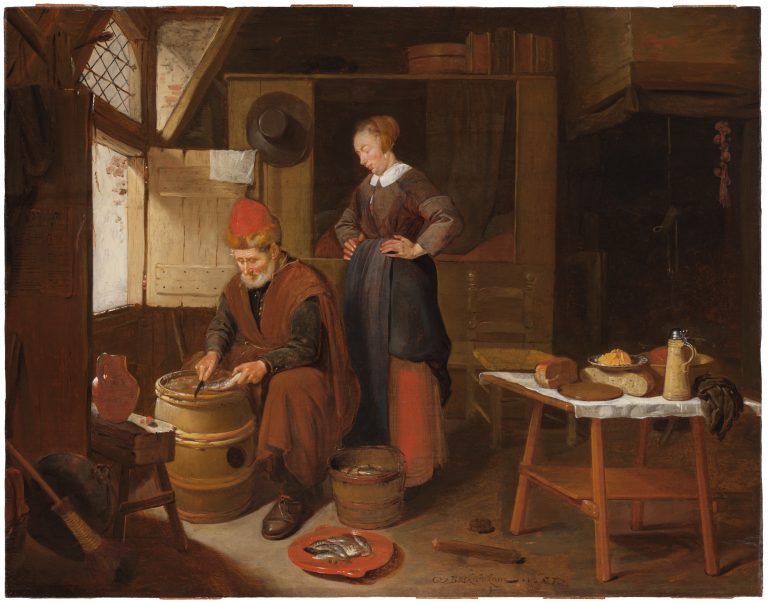Illuminated by light streaming from an open window into a simple room with an earthenware floor, a fisherman descales a pail full of herring under the watchful eyes of his wife who stands, hands on hips, before the couple’s box bed. To their right sits a simple meal of bread, cheese, and a beverage in an earthenware pitcher. A cooking pot hangs in the hearth at the far right of this cozy interior. When Quiringh van Brekelenkam painted this work in 1657, he was already an established artist, having joined the Guild of Saint Luke in 1648.1 Although he frequently depicted artisans such as tailors and spinners in their workshops, in this instance he represented a domestic scene of a fisherman cleaning his catch while his wife waits patiently for him to finish his task.
Van Brekelenkam’s paintings are stylistically less refined than those of his teacher Gerrit Dou (1613–75), which is more appropriate considering the social status of his subjects. As an anonymous eighteenth-century author noted, “his brushwork and treatment were loose and fluent, true to life, and of a benign nature, being a disciple of Dou, whom he followed in a vague way.”2 Van Brekelenkam painted for a less affluent art market than his master, with the hope that his domestic subject matter would appeal to the burgeoning middle class in Leiden. Unfortunately, it seems that his paintings did not command very high prices, which may have been one cause for his persistent financial problems.
In this scene, Van Brekelenkam features the fisherman’s wife as the primary caretaker and probably the dominant personality of the home.3 Her character reflects a well-known passage from the book of Proverbs: “the wife of noble character . . . selects wool and flax and works with eager hand. She is like the merchant ships, bringing her food from afar. She gets up while it is still dark; she provides food for her family and portions for her servant girls” (Prov. 31:13–15). As she waits for her husband to prepare the fish, it is evident that she has prepared the simple meal of bread and cheese and that her house is in clean condition and good order. It is unclear whether all the fish is meant for their own consumption. The wife may also have a role in selling the fish at market. Van Brekelenkam suggests this role through her assertive stance as she gazes at her husband with hands on her hips. Ten years later, Van Brekelenkam depicted a fishmonger at market in a similar fashion (fig 1). Gabriel Metsu (1629–67) also used this body language in the confrontational exchange between two female merchants in his painting The Vegetable Market in Amsterdam, which he executed in the early 1660s (fig 2).
Although Van Brekelenkam painted for a largely middle-class market in the 1650s, he sought to expand his clientele in the 1660s by painting upper-class scenes in a more refined style, similar to those being painted by Dou, Metsu, and Frans van Mieris (1635–81). For example, Sentimental Conversation of the early 1660s (fig 3) displays Van Brekelenkam’s ability to depict fine fabrics in both the gentleman’s jerkin and the fur-trimmed jacket of his elegant companion. Despite their thematic and stylistic differences, Sentimental Conversation and Fisherman and His Wife in an Interior exhibit the same sensitivity to rendering the dynamic relationships between figures and to capturing light effects in interior settings.
